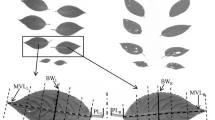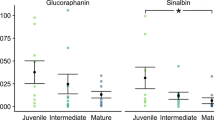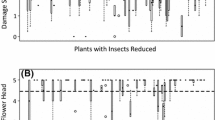Abstract
Plants are able to compensate for loss of tissue due to herbivores at a variety of spatial and temporal scales, masking detrimental effects of herbivory on plant fitness at these scales. The stressing effect of herbivory could also produce instability in the development of plant modules, and measures of such instability may reflect the fitness consequences of herbivory if instability is related to components of plant fitness. We analyse the relationships between herbivory, developmental instability and production of female flowers and fruits of holm oak Quercus ilex trees by means of herbivore removal experiments. Removal of leaf herbivores reduced herbivory rates at the tree level, but had no effect on mean production of female flowers or mature fruits, whereas herbivory tended to enhance flower production and had no effect on fruit abortion at the shoot level. Differences in herbivory levels between shoots of the same branch did not affect the size and fluctuating asymmetry of intact leaves. These results indicate compensation for herbivory at the tree level and over-compensation at the shoot level in terms of allocation of resources to female flower production. Removal of insect herbivores produced an increase in the mean developmental instability of leaves at the tree level in the year following the insecticide treatment, and there was a direct relationship between herbivory rates in the current year and leaf fluctuating asymmetry the following year irrespective of herbivore removal treatment. Finally, the production of pistillate flowers and fruits by trees was inversely related to the mean fluctuating asymmetry of leaves growing the same year. Leaf fluctuating asymmetry was thus an estimator of the stressing effects of herbivory on adult trees, an effect that was delayed to the following year. As leaf fluctuating asymmetry was also related to tree fecundity, asymmetry levels provided a sensitive measure of plant performance under conditions of compensatory responses to herbivory.



Similar content being viewed by others
References
Aarssen LW (1995) Hypotheses for the evolution of apical dominance in plants: implications for the interpretation of overcompensation. Oikos 74:149–156
Alados CL, Emlen JM (1993) Scale asymmetry: a tool to detect developmental instability under the fractal geometry. In: Novak MM (ed) Fractals in the natural and applied sciences. Elsevier, Amsterdam, pp 25–36
Alados CL, Navarro T, Cabezudo B, Emlen JM, Freeman DC (1998) Developmental instability in gynodioecious Teucrium lusitanicum. Evol Ecol 12:21–34
Allison TD (1990) The influence of deer browsing on the reproductive biology of Canada yew ( Taxus canadensis Marsh.). I. Direct effect on pollen, ovule, and seed production. Oecologia 83:523–529
Cannel MGR, Dewar RC (1994) Carbon allocation in trees: a review of concepts for modelling. Adv Ecol Res 25:59–104
Chandler CR (1995) Practical considerations in the use of simultaneous inference for multiple tests. Anim Behav 49:524–527
Crawley MJ (1983) Herbivory. Blackwell, Oxford, UK
Crawley MJ (1985) Reduction of oak fecundity by low-density herbivore populations. Nature 314:163–164
Danell K, Bergström R (2002) Mammalian herbivory in terrestrial environments. In: Herrera CM, Pellmyr O (eds) Plant-animal interactions. An evolutionary approach. Blackwell, Oxford, UK, pp 107–131
Díaz M, Pulido FJ (1995) Relaciones entre abundancia de artrópodos y características vegetativas de la encina Quercus ilex L.: utilidad de su modelización empírica en la gestión forestal de las dehesas. Bol Sanidad Veg Plagas 21:353–260
Díaz M, Møller AP, Pulido FJ (2003) Fruit abortion, developmental selection and developmental stability in holm oaks. Oecologia 135:378–385
Du Merle P, Mazet R (1983) Stades phénologiques et infestation par Tortrix viridana L. (Lep., Tortricidae) des bourgeons du chêne pubescent et du chêne vert. Acta Oecol/ Oecol Appl 4:47–53
Escós JM, Alados CL, Emlen JM (1997) The impact of grazing on plant fractal architecture and fitness in a Mediterranean shrub Anthyllis cytisoides L. Funct Ecol 11:66–78
Escudero A, del Arco JM, Garrido MV (1992) The efficiency of nitrogen retranslocation from leaf biomass in Quercus ilex ecosystems. Vegetatio 99–100:225–237
Freeman DC, Graham JH, Emlen JM (1993) Developmental stability in plants: symmetries, stress and epigenesis. Genetica 89:97–119
Gangestad SW, Thornhill R (1999) Individual differences in developmental precision and fluctuating asymmetry: a model and its implications. J Evol Biol 12:402–416
Gill DE, Chao L, Perkins SL, Wolf JB (1995) Genetic mosaicism in plants and clonal animals. Annu Rev Ecol Syst 26:423–444
Gratani L (1996) Leaf and shoot growth dynamics of Quercus ilex L. Acta Oecol 17:17–27
Järemo J, Tuomi J, Nilsson P, Lennartsson T (1999) Plant adaptation to herbivory: mutualistic versus antagonistic coevolution. Oikos 84:313–320
Leary RF, Allendorf FW (1989) Fluctuating asymmetry as an indicator of stress: Implications for conservation biology. Trends Ecol Evol 4:214-217
Leung B, Forbes MR, Houle D (2000) Fluctuating asymmetry as a bioindicator of stress: comparing efficacy of analyses involving multiple traits. Am Nat 155:101–115
Marquis RJ (1988) Intra-crown variation in leaf herbivory and seed production in striped maple, Acer pennsylvanicum L. (Aceraceae). Oecologia 77:51–55
Martel J, Lempa K, Haukioja E (1999) Effects of stress and rapid growth on fluctuating asymmetry and insect damage in birch leaves. Oikos 86:208–216
Maschinski J, Whitham TG (1989) The continuum of plant responses to herbivory: the influence of plant association, nutrient availability and timing. Am Nat 134:1–19
Møller AP (1995) Leaf mining insects and fluctuating asymmetry in elm ( Ulmus glabra Huds.) leaves. J Anim Ecol 64:697-707
Møller AP (1996) Parasitism and developmental instability of hosts: a review. Oikos 77:189–196
Møller AP (1997) Developmental stability and fitness: a review. Am Nat 149:916–932
Møller AP (1999a) Asymmetry as a predictor of growth, fecundity and survival. Ecol Lett 2:149–156
Møller AP (1999b) Elm Ulmus glabra leaf asymmetry and Dutch elm disease. Oikos 85:109–116
Møller AP, Shykoff JA (1999) Morphological developmental stability in plants: patterns and causes. Int J Plant Sci 160 (Suppl):S135-S146
Møller AP, Swaddle JP (1997) Asymmetry, developmental stability, and evolution. Oxford University Press, Oxford, UK
Møller AP, Gangestad SW, Thornhill R (1999) Nonlinearity and the importance of fluctuating asymmetry as a predictor of fitness. Oikos 86:366–368
Moreno G (2001) Efectos del déficit hídrico en el balance de carbono de la encina ( Quercus ilex L). In: SECF (ed) Montes para la sociedad del nuevo milenio, III Congreso Forestal Español. Junta de Andalucía, Seville, Spain, pp 554–560
Myers JH (1981) Interactions between western tent caterpillars and wild rose: a test of some general plant herbivore hypothesis. J Anim Ecol 50:11–25
Nachman G, Heller KE (1999) Fluctuating asymmetry as an index of fitness: causality or statistical artifact? Oikos 86:357–365
Obeso JR (1993) Does defoliation affect reproductive output in herbaceous perennials and woody plants in different ways? Funct Ecol 7:150–155
Obeso JR, Grubb PJ (1994) Interactive effects of extent and timing of defoliation, and nutrient supply on reproduction in a chemically protected annual Senecio vulgaris. Oikos 71:506–514
Palmer AR, Strobeck C (1986) Fluctuating asymmetry: measurement, analysis, patterns. Annu Rev Ecol Syst 17:391–421
Polak M (1997) Ectoparasitism in mothers causes higher positional asymmetry in their sons: Implications for sexual selection. Am Nat 149:955–974
Primack RB, Hall P (1990) Cost of reproduction in the pink lady’s slipper orchid: a four-year experimental study. Am Nat 136:638–656
Pulido FJ, Díaz M (2002) Dinámica de la regeneración natural del arbolado. In: Pulido FJ, Campos P, Montero G (coords) La gestión forestal de las dehesas. IPROCOR, Mérida, Spain, pp. 39–62
Pulido FJ, Díaz M, Hidalgo SJ (2001) Size-structure and regeneration of holm oak ( Quercus ilex) forests and dehesas: effects of agroforestry use on their long-term sustainability. For Ecol Manage 146:1–13
Rodá F, Gracia C, Retana J, Bellot J (eds) (1999). The ecology of Mediterranean evergreen oak forests. Springer, Berlin Heidelberg New York
Rosenthal R (1991) Meta-analytic procedures for social research. Sage, New York
Sachs T, Novoplansky A, Cohen D (1993) Plants as competing populations of redundant organs. Plant Cell Environ 16:765–770
Sherry RA, Lord EM (1996) Developmental stability in leaves of Clarkia tembloriensis (Onagraceae) as related to population outcrossing rates and heterozygosity. Evolution 50:80–91
Skalski JR (1987) Selecting a random sample of points in circular field plots. Ecology 68:749
Sokal RR, Rohlf FJ (1981) Biometry. Freeman, San Francisco, USA
Strauss SY, Zangerl AR (2002) Plant-insect interactions in terrestrial environments. In: Herrera CM, Pellmyr O (eds) Plant-animal interactions. An evolutionary approach. Blackwell, Oxford, UK, pp 77–106
Templado JL (1990) Datos fenológicos sobre lepidópteros defoliadores de la encina. SHILAP Rev Lepid 18:325–334
Wardlaw IF (1990) The control of carbon partitioning in plants. New Phytol 116:341–381
Watson PJ, Thornhill R (1994) Fluctuating asymmetry and sexual selection. Trends Ecol Evol 9:21–25
Whigham DF (1990) The effect of experimental defoliation on the growth and reproduction of a woodland orchid, Tipularia discolor. Can J Bot 68:1812–1816
Wilsey BJ, Haukioja E, Koricheva J, Sulkinoja M (1998) Leaf fluctuating asymmetry increases with hybridization and elevation in tree-line birches. Ecology 79:2092–2099
Winn AA (1996) Adaptation to fine-grained environmental variation: an analysis of within-individual leaf variation in an annual plant. Evolution 50:1111–1118
Wright SP (1992) Adjusted P-values for simultaneous inference. Biometrics 48:1005–1013
Yezerinac SM, Lougheed SC, Handford P (1992) Measurement error and morphometric studies: statistical power and observer experience. Syst Biol 41:471–482
Zar JH (1996) Biostatistical analysis, 3rd edn. Prentice-Hall, New Jersey, USA
Zvereva EL, Kozlov MV, Haukioja E (1997a) Stress responses of Salix borealis to pollution and defoliation. J Appl Ecol 34:1387–1396
Zvereva EL, Kozlov MV, Niemelä P, Haukioja E (1997b) Delayed induced resistance and increase in leaf fluctuating asymmetry as responses of Salix borealis to insect herbivory. Oecologia 109:368–373
Acknowledgements
Hilda Fernández de Córdova and Carlos Marcos gave us permission to work on their land. Chema Torres helped us during field work and J. Barandica, F. López and J.V. Zorrilla with leaf area measurements. J. Clobert gave us statistical advice. Comments of T. Sachs, G. Moreno and K.C. Larson on an early draft and those of two anonymous referees during review were very helpful. F.J.P. was funded by an FPI grant from the Consejería de Educación y Juventud of the Junta de Extremadura while carrying out field work, and M.D. by a grant of the Spanish CICYT while writing the manuscript. This paper is a contribution to the project PAC-02–008 of the Junta de Comunidades de Castilla-La Mancha.
Author information
Authors and Affiliations
Corresponding author
Rights and permissions
About this article
Cite this article
Díaz, M., Pulido, F.J. & Møller, A.P. Herbivore effects on developmental instability and fecundity of holm oaks. Oecologia 139, 224–234 (2004). https://doi.org/10.1007/s00442-004-1491-9
Received:
Accepted:
Published:
Issue Date:
DOI: https://doi.org/10.1007/s00442-004-1491-9




